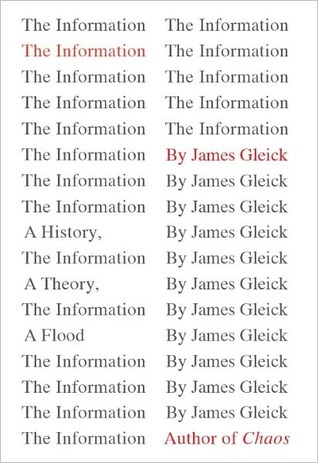More on this book
Community
Kindle Notes & Highlights
An invention even more profound and more fundamental came in a monograph spread across seventy-nine pages of The Bell System Technical Journal in July and October. No one bothered with a press release. It carried a title both simple and grand—“A Mathematical Theory of Communication”—and the message was hard to summarize. But it was a fulcrum around which the world began to turn. Like the transistor, this development also involved a neologism: the word bit, chosen in this case not by committee but by the lone author, a thirty-two-year-old named Claude Shannon. The bit now joined the inch, the
...more
“Theories permit consciousness to ‘jump over its own shadow,’ to leave behind the given, to represent the transcendent, yet, as is self-evident, only in symbols.”
In the nineteenth century, energy began to undergo a similar transformation: natural philosophers adapted a word meaning vigor or intensity. They mathematicized it, giving energy its fundamental place in the physicists’ view of nature. It was the same with information. A
We have met the Devil of Information Overload and his impish underlings, the computer virus, the busy signal, the dead link, and the PowerPoint presentation.
Since the late nineteenth century, linguists have identified the phoneme as the smallest acoustic unit that makes a difference in meaning. The English word chuck comprises three phonemes:
if, either, or.
The next year, in England, the chief engineer of the General Post Office, William Preece, reported to Parliament: “I fancy the descriptions we get of its use in America are a little exaggerated, though there are conditions in America which necessitate the use of such instruments more than here. Here we have a superabundance of messengers, errand boys and things of that kind. . . . I have one in my office, but more for show. If I want to send a message—I use a sounder or employ a boy to take it.”
After q, a u is expected. There is no surprise. It contributes no information. After the letter t, an h has a certain amount of redundancy, because it is the likeliest letter to appear. Every language has a certain statistical structure, Shannon argued, and with it a certain redundancy. Let us call this (he suggested) D. “D measures, in a sense, how much a text in the language can be reduced in length without losing any information.” Shannon estimated that English has redundancy of about 50 percent.2 Without computers to process
In the case of ordinary speech, these elements are the speaker’s brain, the speaker’s vocal cords, the air, the listener’s ear, and the listener’s brain. As prominent as the other elements in
First law: The energy of the universe is constant. Second law: The entropy of the universe always increases. There are many other formulations of these laws, from the mathematical to the whimsical, e.g., “1. You can’t win; 2. You can’t break even either.” But this is the cosmic, fateful one. The universe is running down. It is a degenerative one-way street. The final state of maximum entropy is our destiny. William Thomson, Lord Kelvin, imprinted the
For this bodiless replicator itself, Dawkins proposed a name. He called it the meme, and it became his most memorable invention, far more influential than his selfish genes or his later
He regretted that name soon enough, when the IBM marketing department featured his work in an advertisement with the line “Stand by: I’ll teleport you some goulash.” But the name stuck, because teleportation worked. Alice does not send goulash; she sends qubits.3 The qubit is the smallest nontrivial quantum system. Like a classical bit, a qubit has two possible values, zero or one—which is to say, two states that can be reliably distinguished. In a classical system, all states are distinguishable in
In quantum computing, multiple qubits are entangled. Putting qubits at work together does not merely multiply their power; the power increases exponentially. In classical computing, where a bit is either-or, n bits can encode any one of 2n values. Qubits can encode these Boolean values along with all their possible superpositions. This gives a quantum computer a potential for parallel processing that has no classical equivalent. So quantum computers—in theory—can solve certain classes of problems that had otherwise been considered computationally infeasible.
Quantum computing is another matter. The ability of a quantum computer to occupy many states at once opens new vistas. In 1994, before anyone knew how actually to build any sort of quantum computer, a mathematician at Bell Labs figured out how to program one to solve the factoring problem. He was Peter Shor, a problem-solving prodigy who made an early mark in math olympiads and prize competitions. His ingenious algorithm, which broke the field wide open, is known by him simply as the factoring algorithm, and by everyone else as Shor’s algorithm. Two years later Lov Grover, also at Bell Labs,
...more
Quantum information is like a dream—evanescent, never quite existing as firmly as a word on a printed page. “Many people can read a book and get the same message,” Bennett says, “but trying to tell people about your dream changes your memory of it, so that eventually you forget the dream and remember only what you said about it.” Quantum erasure, in turn, amounts to a true undoing: “One can fairly say that even God has forgotten.” As for Shannon himself, he was unable to witness this flowering of the seeds he had planted. “If
This new world encyclopedia would transcend the static form of the book, printed in volumes, said Wells. Under the direction of a wise professional staff (“very important and distinguished men in the new world”), it would be in a state of constant change—“a sort of mental clearinghouse for the mind, a depot where knowledge and ideas are received, sorted,


